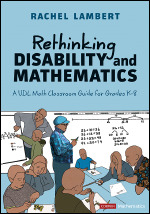Rethinking Disability and Mathematics
A UDL Math Classroom Guide for Grades K-8
Foreword by Megan Franke
Corwin Mathematics Series
Every child has a right to make sense of math, and to use math to make sense of their worlds.
Despite their gifts, students with disabilities are often viewed from a deficit standpoint in mathematics classrooms. These students are often conceptualized as needing to be fixed or remediated. Rethinking Disability and Mathematics argues that mathematics should be a transformative space for these students, a place where they can discover their power and potential and be appreciated for their many strengths. Author Rachel Lambert introduces Universal Design for Learning for Math (UDL Math), a way to design math classrooms that empowers disabled and neurodiverse students to engage in mathematics in ways that lead to meaningful and joyful math learning. The book showcases how UDL Math can open up mathematics classrooms so that they provide access to meaningful understanding and an identity as a math learner to a wider range of students. Weaved throughout the book are the voices of neurodiverse learners telling their own stories of math learning.
Through stories of real teachers recognizing the barriers in their own math classrooms and redesigning to increase access, the book:
- Reframes students with disabilities from a deficit to an asset perspective, paving the way for trusting their mathematical thinking
- Offers equitable math instruction for all learners, including those with disabilities, neurodiverse students, and/or multilingual learners
- Applies UDL to the math classroom, providing practical tips and techniques to support students' cognitive, affective, and strategic development
- Immerses readers in math classrooms where all students are engaged in meaningful mathematics, from special education day classes to inclusive general education classrooms, from grades K-8.
- Integrates research on mathematical learning including critical math content such as developing number sense and place value, fluency with math facts and operations, and understanding fractions and algebraic thinking.
- Explores critical issues such as writing IEP goals in math
This book is designed for all math educators, both those trained as general education teachers and those trained as special education teachers. The UDL Math approach is adapted to work for all learners because everyone varies in how they perceive the world and in how they approach mathematical problem solving. When we rethink mathematics to include multiple ways of being a math learner, we make math accessible and engaging for a wider group of learners.
Rachel Lambert skillfully delivers cogent background and advice for addressing the complexity of teaching mathematics to students with disabilities. By contextualizing all approaches in an environment of high expectations, trust, and strengths-based instructional approaches, she suggests a carefully crafted continuum to spur one to rethink what mathematics educators and special educators do. Every individual engaged in working with K–8 learners needs to delve into this critical information. Let the sense-making begin.
This book by Rachel Lambert, a leading expert in special education and mathematics education, is an invaluable contribution to our thinking and knowledge of the best ways to support students with learning differences in their understanding of mathematics. A must-read for any educator or parent.
This book is long overdue! I applaud Lambert for challenging mathematics educators to reimagine what students with disabilities are capable of in mathematics. Lambert confronts the deficit perspectives that have permeated the way many educators think about students with disabilities in mathematics. Lambert also provides specific examples that show that students with disabilities can engage in rich, cognitively demanding mathematics when given the proper support and guidance.
All too often in my career, I’ve heard neurodiverse students discussed in deficit ways in terms of their opportunities to know and do mathematics. Lambert’s book provides shining examples of strategies we can use to empower and provide access to neurodiverse students so that they can demonstrate their full mathematical brilliance in math class. The strategies described are simultaneously revelatory and straightforward to implement.
UDL can now truly become a tool that mathematics educators can use to change how they go about designing mathematics experiences for disabled students.
This book is a transformer! Rethinking Disabilities and Mathematics is a must-read for all educators. Dr. Lambert provides insight into different types of disabilities and strategies to implement UDL Math to engage and support learners in developing positive mathematics identities. She goes beyond strategies and instruction, giving us clarity through the lens of different perspectives that will make educators rethink disability.
As I read this extraordinary book, it felt like I was having a conversation with Rachel Lambert. Connecting with my innermost being in a deep and meaningful way; this is what is needed to change mindsets and practices. The vignettes, coupled with well-documented research, allow the reader to reflect on their own experiences and teaching schema with practical transformative methods from the perspective of not only researchers but also authentically from teachers.
The word “strength” rarely makes its way into conversations about students’ disabilities in school buildings. In Lambert’s work, strength is a basic tenet of students with disabilities. From classroom visits to conversations with mathematicians with disabilities, Lambert unveils a landscape of possible math learning with a UDL Math framework and strengths-based pedagogies because disabled learners were never the problem to be fixed in math education, the system is.
If there is one book you need to read about the field of special education and mathematics, this is it. Rachel Lambert has torn apart our old tapestry of beliefs and teaching practices and rewoven another with clarity, powerful examples, and research. This book breaks new ground.
This is a groundbreaking exploration that transcends traditional teaching paradigms and revolutionizes our perspectives on disability in mathematics education. With insightful chapters exploring the brilliance of diverse learners, real-life stories, and rigorous research on UDL, it empowers educators with a strengths-based approach. A transformative guide, it ignites introspection and catalyzes action, shaping a more inclusive mathematical landscape.
